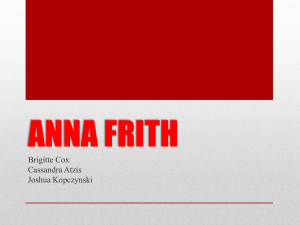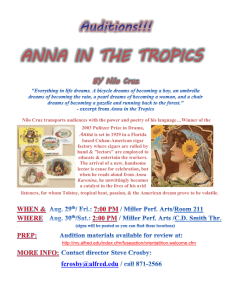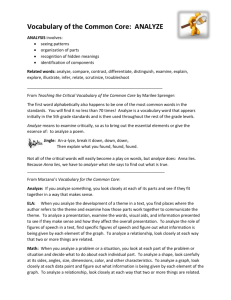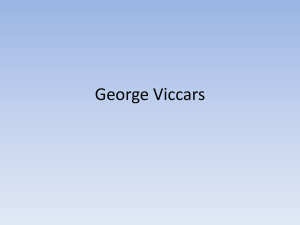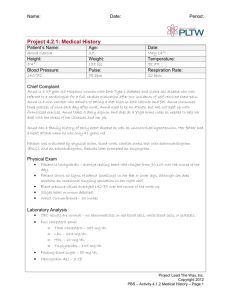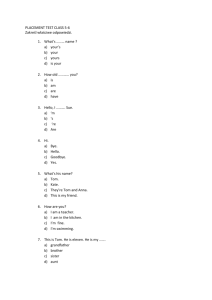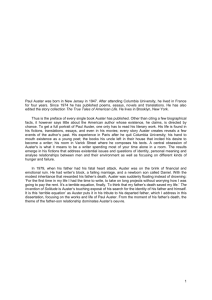Penetrating “the Labyrinth of Endless Steps”
advertisement
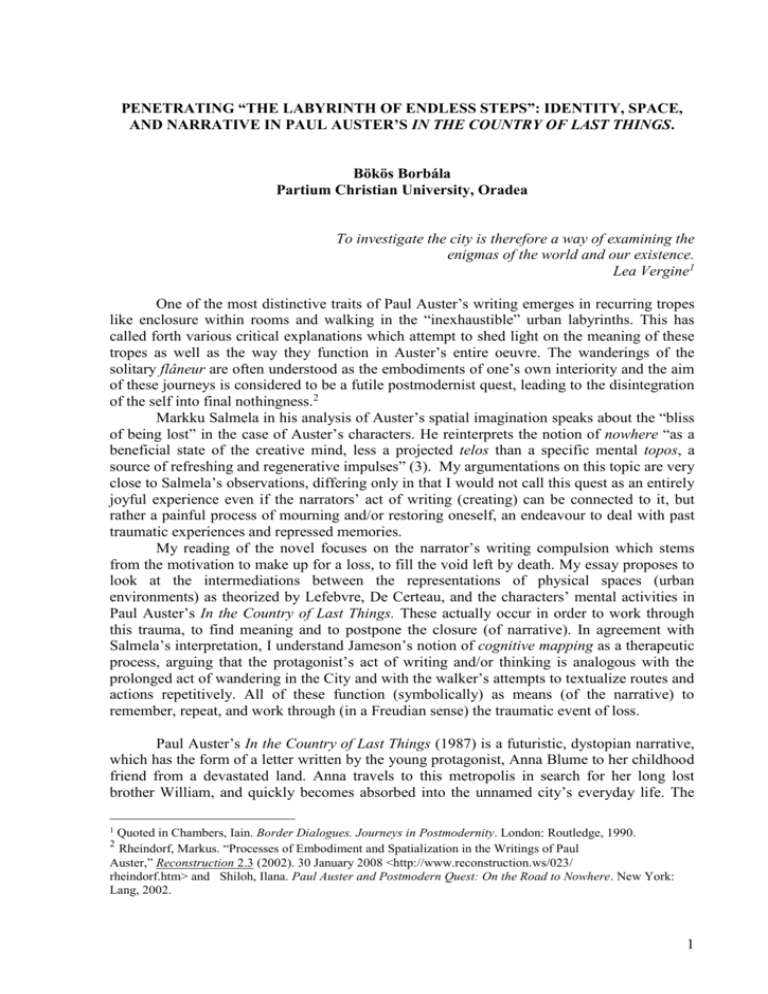
PENETRATING “THE LABYRINTH OF ENDLESS STEPS”: IDENTITY, SPACE, AND NARRATIVE IN PAUL AUSTER’S IN THE COUNTRY OF LAST THINGS. Bökös Borbála Partium Christian University, Oradea To investigate the city is therefore a way of examining the enigmas of the world and our existence. Lea Vergine1 One of the most distinctive traits of Paul Auster’s writing emerges in recurring tropes like enclosure within rooms and walking in the “inexhaustible” urban labyrinths. This has called forth various critical explanations which attempt to shed light on the meaning of these tropes as well as the way they function in Auster’s entire oeuvre. The wanderings of the solitary flâneur are often understood as the embodiments of one’s own interiority and the aim of these journeys is considered to be a futile postmodernist quest, leading to the disintegration of the self into final nothingness.2 Markku Salmela in his analysis of Auster’s spatial imagination speaks about the “bliss of being lost” in the case of Auster’s characters. He reinterprets the notion of nowhere “as a beneficial state of the creative mind, less a projected telos than a specific mental topos, a source of refreshing and regenerative impulses” (3). My argumentations on this topic are very close to Salmela’s observations, differing only in that I would not call this quest as an entirely joyful experience even if the narrators’ act of writing (creating) can be connected to it, but rather a painful process of mourning and/or restoring oneself, an endeavour to deal with past traumatic experiences and repressed memories. My reading of the novel focuses on the narrator’s writing compulsion which stems from the motivation to make up for a loss, to fill the void left by death. My essay proposes to look at the intermediations between the representations of physical spaces (urban environments) as theorized by Lefebvre, De Certeau, and the characters’ mental activities in Paul Auster’s In the Country of Last Things. These actually occur in order to work through this trauma, to find meaning and to postpone the closure (of narrative). In agreement with Salmela’s interpretation, I understand Jameson’s notion of cognitive mapping as a therapeutic process, arguing that the protagonist’s act of writing and/or thinking is analogous with the prolonged act of wandering in the City and with the walker’s attempts to textualize routes and actions repetitively. All of these function (symbolically) as means (of the narrative) to remember, repeat, and work through (in a Freudian sense) the traumatic event of loss. Paul Auster’s In the Country of Last Things (1987) is a futuristic, dystopian narrative, which has the form of a letter written by the young protagonist, Anna Blume to her childhood friend from a devastated land. Anna travels to this metropolis in search for her long lost brother William, and quickly becomes absorbed into the unnamed city’s everyday life. The 1 Quoted in Chambers, Iain. Border Dialogues. Journeys in Postmodernity. London: Routledge, 1990. Rheindorf, Markus. “Processes of Embodiment and Spatialization in the Writings of Paul Auster,” Reconstruction 2.3 (2002). 30 January 2008 <http://www.reconstruction.ws/023/ rheindorf.htm> and Shiloh, Ilana. Paul Auster and Postmodern Quest: On the Road to Nowhere. New York: Lang, 2002. 2 1 town undergoes a haunting, terrifying disintegration: streets and buildings disappear day-today, people try to survive through killing, mugging, stealing, and scavenging. The mysterious, oppressive government is always in transience, and considers as its primary aim to collect human waste as well as corpses for producing energy. Escaping the chaotic City seems to be impossible, thus in order to survive Anna has to become an object hunter, a scavenger. She finds shelter with Isabel and her mad husband, later falling in love with Samuel Farr, a journalist-writer, who intends to write the story of the City. The physical environment and the characters in the novel are in a permanent state of transience, unsettledness, and deprivation. According to Markku Salmela they are entrapped in a “downward spiral”, which signifies the instability of the urban cultural order, and brings about homelessness and the lack of orientation (112-13). In order to define and understand the mislocation of the characters’ self and their desire to be lost in the City, the distinction between the notions of space and place as theorized by Lefebvre, De Certeau, and Yi-Fu Tuan becomes noteworthy. Henri Lefebvre in his The Production of Space introduces the concepts of perceived, conceived and lived spaces, or – as he prefers to call them – spatial practice, representations of space and representational spaces. Perceived space or spatial practice has a socio-political significance: it refers to the reproductions of social relations and everyday social practices, including both the daily routines, itineraries, and the locations where these operations occur. Conceived space or the representations of space refers to the conceptualized, abstract space. It is the dominant space of scientists and planners, thus imposing an order upon society. It embodies the relationships of power, control, and production. Lived space or representational space is the practical, and directly experienced social space of the daily activities of “users/inhabitants.”3 Lefebvre manifests his concepts in analysing the history of spaces, thus demonstrating that space and time are close connected. In the novel, Anna Blume’s experiences demonstrate the interrelations that occur between the conceived space and the lived space. As Woods argues, place as a specific demarcation of space is crucial to the establishment of the social order. Therefore, Anna Blume’s attempts to challenge what the place might be is to challenge something fundamental in the social order (112). Her narrative can be seen as a direct act of resistance against the linguistic and spatial domination imposed by the novel’s world (Salmela 137). According to Michel de Certeau, the basic distinction between space and place is caused by temporality. A place (lieu) is an order, a configuration of positions, excluding the possibility of two things being in the same place. Thus, it implies stability, and fixed relations. Space is constituted of the intersection of the mobile elements, it occurs as an effect of the practices that orient it, and temporalize it. De Certeau concludes that space is a practiced place that is for example when the streets become transformed into spaces by the walkers on them. In his essay “Walking in the City”, De Certeau defines the verb “to walk” as a practice of lacking a place.4 For him, narrative draws in the transformation of place into space (118). Places bring about a stability, which must be disrupted in order for narratives to unfold. Spaces, on the other hand, are places that have been practiced, acted upon, thus becoming the locations for narrative events. A similar distinction can be drawn between maps and tours, in which maps serve to denote places, while tours denote an active process, a movement through spaces, bringing about the fundamental human perception of spatiality (119). De Certeau describes “the city” as made up by the “walkers, Wandersmänner, whose bodies follow the cursives and strokes of an urban text they write without reading” (92). These ground-level pedestrians do not enjoy the position and perspective of the “voyeur-god”, and are therefore trapped within the city. Paradoxically, they are writing the “urban text”, without being able to 3 4 Lefebvre, Henri. The Production of Space. Oxford: Blackwel, 1991. De Certeau, Michel. The Practice of Everyday Life. Berkely: U of California Press, 1984 2 read it, thus becoming unintentional storytellers. In other words – as Markku Salmela points out – when the vantage point is lowered to street level, where pedestrians follow their routes (…) the focus of activity turns from observation to productive action, metaphorically from reading to writing (53). Auster’s perception of the city is similar: many sections provide the description of the patterns traced through the city by Ana’s paths, and her act of writing and/or thinking becomes analogous with her prolonged act of wandering in the City: “The streets of the city are everywhere, and no two streets are the same. I put one foot in front of the other, and then the other foot in front of the first, and then hope I can do it again. Nothing more than that (…) Unless I write down things as they occur to me, I fell I will lose them for good (…) The words come only when I think I won’t be able to find them anymore, at the moment of despair of ever bringing them out again” (CLT 2-38). Paul Auster himself has a great interest in the intermediation between textual and physical space. In his semi – autobiographical writing entitled The Invention of Solitude he meditates upon the possible analogies between physical and cognitive motions. Markku Salmela identifies a structural equality between the three realms that make up Auster’s “limits of the known world”: the public space (streets), private space(room), and textual space(the act of writing)5. Similarly, Auster describes the act of walking as a concrete manifestation of metal processes: “what we are really doing when we walk through the city is thinking, and thinking in such a way that pure thoughts compose a journey, and this journey is no more or less than the steps we have taken” (Solitude 122). Accordingly, a mere thought, even before it is written on the paper, starts to resemble a spatial act, therefore textual space and cognitive space become practically indistinguishable (Salmela 42). Blume’s narration sheds light upon the juxtaposition of interior and exterior spaces, or as Woods argues, “her urban experience allows public space to be the stage for private experiences, and private spaces to be unfolded onto public spaces” (108-09). What also emerges in the novel is akin to Anthony Vidler’s concept of the spatial uncanny as something which does not necessarily refer to buildings or spaces summoning an uncanny feeling, but to a “spatial estrangement [which] represents precisely that mingling of mental projection and spatial characteristics associated with the uncanny” (Vidler 11). Similarly, the transformations in the city can reflect the psyche of the characters: Anna Blume feels estranged in a city, as the streets appear and disappear, and the rumours of other places existing outside of the city are considered as the products of imagination. What also characterizes the journey of Anna Blume is endlessness, as the “city” is always experienced as an endlessly familiar, endlessly repetitive space, thus enhancing the motif of the labyrinth. She begins her letter with the description of this uncanny labyrinth: “these are the last things. A house is there one day, and the next day it is gone. A street you walked down yesterday, is no longer there today” (1). “The city” thus becomes a living being and because it is all-pervasiveness, it dehumanizes all of its inhabitants, it “makes people too small to be human anymore”(74).The devastated metropolis is experienced by the Anna Blume as a lifeless, objectless, godless place, in which people are faced with isolation and anonymity in the midst of similarly nameless masses: “Slowly and steadily, the city seems to be consuming itself, even as it remains (…) the streets are the worst, for there you are exposed to every hazard and inconvenience” (21-22). Similarly to De Certeau’s ideas, Yi-Fu Tuan argues that place can signify “pause” when compared to the free movement allowed by space. He opposes the “security and Markku Salmela’s analysis focuses on the textual itineraries in Auster’s the City of Glass and his other autobiographical writings, investigating the relationship between the concepts of reading the text and reading the city (77-105). 5 3 stability of place” to “the openness, freedom, and threat of space”, thus being lost involves the lack of a sense of security, of a place (Tuan qtd in Salmela 102)6. In the case of Anna Blume, the lack of a proper home, and more precisely the loss of it after Isabel’s death induces the feeling of “being nowhere”: I had to give up the idea of going home (…) First Isabel had died and I had lost the apartment. My only consolation had been the thought of home, and now that suddenly had been taken from me as well. For the first time since coming to the city, I was engulfed by pessimism (CLT 89). What this excerpt divulges is precisely the all-pervasiveness of the threatening space, which introduces a certain “unsettledness”, and brings about more and more disorientation. According to Markku Salmela, the protagonist is dependent on this condition of aimlessness and detachment from the surroundings, which liberates the mind from the bounds of reason (103). Anna Blume acquires a state of self-(re)production during the time she spends walking aimlessly in the city. Thus, the concept of the nowhere becomes a refuge for the mind, and the absence of any anchoring points can bring about the feeling of freedom, akin to a therapeutic effect. However, I would not call this quest as an entirely joyful experience, but rather a painful process of mourning and/or restoring oneself, an endeavour to deal with past traumatic experiences and repressed memories. Walking in the city and writing her letter are simultaneous actions which occur to keep Anna Blume alive: “I feel there is something to say, and if I don’t quickly write it down, my head will burst. It doesn’t matter if you read it. It doesn’t even matter if I send it” (3). Her writing compulsion stems from the motivation to make up for a loss, to fill the void left by one’s death. Anna Blume starts to write the letter after Isabel’s death, an attempt which represents a symbolic restoration of a psychic core of loss and mourning: “there was the notebook with all those blank pages in it, and suddenly I felt an overwhelming urge to pick up one of the pencils and begin this letter. By now, it is the only thing that matters to me: to have my say at last, to get it all down on these pages before it is too late” (79). Thus walking in the city combined with the act of writing are repetitive, compulsive actions which actually take place to fill up the absence, the empty emotional space that persists as an unresolved mourning. Furthermore, the compulsion to write can be interpreted as the characters’ attempt to prolong their existence in the text, thus prolonging the narrative. I understand writing into the notebook as the artist’s attempt to escape from a past trauma, from a loss or pain; it is an attempt to write it out, to get through an unspeakable traumatic experience. Ana Blume would have gone mad if she could not had the possibility to write down all her experiences. After experiencing another loss, that of the disappearance of the rabbi, Anna claims: “Everything disappears, people just as surely as objects, the living along with the dead. I mourned the loss of my friend, felt pulverized by the sheer weight of it (…) Sam’s book became the most important thing in my life. As long as we kept working on it, I realized, the notion of a possible future would continue to exist for us”(113-14). I argue that Anna performs an act of survival through storytelling to escape from the void, and from the meaninglessness of her condition. Hence the importance of storytelling: it is a means of remembering, an act a posteriori, it tries to repeat what is no longer there, what is gone forever. Anna tries to (re)estabilish her identity by means of narrating, telling stories of the past and of the present. Without remembering and documenting her existence, there would be no sense of identity, thus remembering has the role to construct and/or preserve self-identity, self-sameness. She is writing the letter to keep herself alive. 6 In another attempt to define the differences between space and place, Edward Casey argues that place is a geographical location of the self, for which space functions as a void-like context. Contrastingly, De Certeau argues that space is produced by action that intrudes the void of place (qtd in Salmela 139). 4 At the same time, Anna Blume’s urge to relocate herself in this haunting urban space is a process that recalls Jameson’s notion of “cognitive mapping”. Fredric Jameson claims that “disalienation in the traditional city involves the practical reconquest of a sense of place and the construction and reconstruction of an articulated ensemble which can be retained in memory and which the individual subject can map and remap along the moments of mobile, alternative trajectories” (51). Thus, the act of walking becomes a linguistic expression of a succession of mental images7. Woods argues that the city can be seen as a “logarithm” that contains the structure and texture of all individual urban experiences. The city space in Auster’s novel functions as both a scene of textual events and a text for individual interpretation. Thus, the city emerges as a text in which Anna Blume is “looking for the signs” (6) in order to (re)locate herself, to find meaning8. However, the city does not allow itself to be read. For Jameson, the inability to map the urban space points to the inability to position oneself in social and political space. Reflecting upon Jameson’s usage of this term, Mark Turner defines cognitive mapping as a concept which belongs to the realm of linguistics and cognitive science, closely connected to the processes of metaphoric thinking, and to the general idea that thoughts are primarily organized metaphorically. Thus, a cognitive map structures the basic processes of the human mind, and it can also be defined as a process of thinking about spatial relations (qtd in Salmela 57). Anna’s attempts at such mapping constantly fail, and her possibilities to act and move freely are also blocked by the city’s continuous physical decomposition. The disappearance of things brings about a selective amnesia: “it’s not just that things vanish – but once they vanish, the memory of them vanishes as well” (87). First the objects disappear (nobody remembers what is an airplane, for example), then the words which denote them. Thus, the decomposition of the memory corresponds to the loss of the words, to the disintegration of the language: “it is a slow but ineluctable process of erasure. Words tend to last a bit longer than things, but eventually they fade too, along the pictures they once evoked (…) little by little, the words become only sounds, a random collection of glottals and fricatives, a storm of whirling phonemes, and finally the whole thing just collapses into gibberish” (89). Anna Blume’s narrative also bears the burden of this linguistic disintegration, as Salmela observes, she “intermittently abandons chronology and linearity in an effort to retrieve as much as possible from her memory” (125). The loss of identity in the case of Anna roots in her detachment from her surroundings. Her journey is a symbolic response to a loss which occurred through separation/abandonment first, then through the death of the beloved ones (Isabel, the rabbi, her never born child), and initiated a series of emotional outbursts in her: wrath, melancholy, hopelessness, depression and later a strong instinct of survival. According to Freud, remembering has the function “to fill in the gaps in memory [and] to overcome resistance due to repression” (Freud 141), a process which also involves repetition as a “transference of the forgotten past”(Freud 151). Thus remembering, repeating and working-through9 mark a process through which the subject becomes conversant with his resistances, finally being able to overcome them (Freud 155). What is to mourn the loss of identity? How to work through such a trauma? This linguistic analogy is also discussed by De Certeau, as he argues that “the act of walking is to the urban system what the speech act is to language or to the statements uttered” (qtd in Salmela 81). 8 Reflecting upon Lefebvre’s question: “to what extent may a space be read or decoded?,” Woods argues that what Auster does in his fiction, is precisely to work at the as-yet concealed between space and language (115). 9 Freud also attributes the necessity of working-through to the resistance of the unconscious (or of the Id) (156). 7 5 In my reading, in the novel remembering and the memory are closely related to identity. The sense of past in the city is disappearing, as a result of the erasure of the different material objects, the things which do not last, and “once a thing is gone, that is the end of it” (2). It seems that the best option for Anna is to deny her identity at first, trying to erase every personal experience, a process which leads to the disappearance of the self: “Never think about anything (…) Just melt into the streets and pretend that your body doesn’t exist. No musings; no sadness or happiness; no anything but the street, all empty inside, concentrating only on the next step you are about to take” (57). The loss of identity is also accompanied by the forgetting of the past and memories. In Auster’s The Invention of Solitude memory is connected to history, and it is defined as “a space in which a thing happens for a second time”(83). As Woods asserts, memory is here conceived of as a space in which history repeats itself (121)10. However, this “amnesia”, the desire to forget the past can be seen here as an attempt for re-definition and the need to start everything over again: You no longer know how to act, and because you cannot act, you find yourself unable to think. The brain is in a muddle (…) One change follows another, each day produces a new upheaval (…) That is the dilemma. On the one hand , you want to survive, to adapt, to make the best of things as they are. But on the other hand, to accomplish this seems to entail killing off all those things that once made you think of yourself as human (…) In order to live, you must make yourself to die (20). Paradoxically, it is an act of forgetting, in order to remember and reconstruct identity. Consequently, memory cannot be seen here exclusively as a matter of interiority and exteriority, but also as a juxtaposition of remembering and forgetting, as Anna writes: “each day brings the same struggle, the same blankness, the desire to forget and then not to forget” (38). Accordingly, the text also happens to forget itself, in order to reinvent itself, to start itself over and over again. Anna Blume asserts : “the story starts and stops, goes forward and then loses itself, and between each word, what silences, what words escape and vanish, never to be seen again” (38). Why does the text repeatedly look back to itself, why must it remember itself? Remembering takes place in order to come to terms with one’s identity, to find peace with personal history and to find meaning. In this sense, Anna’s process of scavenging can also be symbolic for her attempt of (re)membering, of putting together both the objects that were lost, parts of her shattered memory, and finally her narrative11. At the same time, remembering is similar to mourning, as it endeavours to make up for a loss, to regain what is gone forever. In setting out on the journey to find her lost brother, Anna Blume is apprehending her own transitoriness and death, and finally is offered a new hope of continuity through storytelling. The meeting with Victoria Woburn functions as a catalyst in Anna’s transformation: Victoria saves her from death, and reveals to her the role of the Woburn House that is to help people. At the beginning, the Woburn House seems to be a perfect place of mourning for Anna, as she writes that “my baby was no longer inside me (…) It was a dark period for me (…) for the first ten or twelve days, I don’t think I even managed to go into the hallway outside the door” (128-30). However, the Woburn House stands in sharp contrast with the City: it is a “heaven, an idyllic refuge from the misery and squalor around it” (139). The more Anna becomes involved in the charity work of the Woburn House, the more she becomes able to release her 10 Woods further argues that for this reason, memory has the potential to be a crucial source of political resistance and autonomy. Blume’s attempts to resurrect these lost or absent objects and the words which denote them, can be interpreted as a form of social insurrection, thus her narrative becomes a potent, anti-authoritarian political tool in the novel (120-21). 11 Bernd Herzogenrath interprets Anna’s act of scavenging as an endless process of signification, the building of a new, textual world (102-103). 6 anger and to work-through her past traumas. As Freud states, “remembering at once gives way to acting out” (141), and Anna finally breaks through mourning, defining her letter as a “calling out (…), screaming into a vast, terrible blankness” (183). Nearly at the end of the novel, Anna Blume refers to her own narrative as an endless act of survival: The closer you come to the end, the more there is to say. The end is only imaginary, a destination you invent to keep yourself going, but a point comes when you realize you will never get there. You might have to stop, but that is only because you have run out of time. You stop, but that does not mean you have come to the end (183). In the case of Anna, storytelling functions as a form of resistance against death, it takes place in order to postpone the end (of the narrative). As Woods argues, “death, rather than functioning as a form of narrative closure, actually spices up the narrative and urges a new opening to life” (122)12. In this sense, the concept of nowhere, the city-space with its allpervasive meaninglessness appears as a mere site for the confrontation with death. Conclusively, the acts of walking/writing become to represent a process of release and transcendence, significantly, death does not function as a means of escape, but as the beginning of an artistic process, both the motivation and the result. Works cited: Auster, Paul. In the Country of Last Things. New York: Viking Penguin, 1987. --- . The Invention of Solitude. London: Faber, 1992 Chambers, Iain. Border Dialogues. Journeys in Postmodernity. London: Routledge, 1990. De Certeau, Michel. The Practice of Everyday Life. Berkely: U of California Press, 1984 Freud, Sigmund. (1914g). Errinern, Wiederholen und Durcharbeiten (Weitere Ratschläge zur Technik der Psychoanalyse, II). Internationale Zeitschrift für ärtztliche Psychoanalyse, 2, 485-491; Remembering, repeating and working-through. SE, 12: 145-156. Herzogenrath, Berndt. An Art of Desire: Reading Paul Auster. Amsterdam: Rodopi, 1999 Jameson, Fredric. Postmodernism or the Cultural Logic of Late Capitalism. London: Verso, 1991 Lefebvre, Henri. The Production of Space. Oxford: Blackwel, 1991. Salmela, Markku. Paul Auster’s Spatial Imagination. Tampere: U Press, 2006. 12 In The Invention of Solitude Auster also reflects upon the role of storytelling as a life-giving force, through analysing the story of Seherezad (150-54). 7 Vidler, Anthony. The Architectural Uncanny. Essays in Modern Unhomely. Cambridge, MA: MIT, 1992. 132 Woods, Tim. “Looking for Signs in the Air: Urban Space and the Postmodern in In the Country of the Last Things.” In Barone, Dennis, ed. Beyond the Red Notebook: Essays on Paul Auster. Philadelphia: U of Pennsylvania Press, 1995. Works consulted: Freud, Sigmund. (1916-1917g [1915]) "Trauer und Melancholie," Intern. Zschr. ärztl. Psychoanal 4, p. 277-287; G.W., 10, 428-448; Mourning and melancholia. SE, 14: 243-258. Rheindorf, Markus. “Processes of Embodiment and Spatialization in the Writings of Paul Auster,” Reconstruction 2.3 (2002). 30 January 2008 <http://www.reconstruction.ws/023/rheindorf.htm> Shiloh, Ilana. Paul Auster and Postmodern Quest: On the Road to Nowhere. New York: Lang, 2002. Auster, Paul. In the Country of Last Things. Book cover. 8 Wandersmänner, flâneur, writer of “urban texts” 9 Wanderer above the Sea of Fog (1818) by Caspar David Friedrich 10 The long walk (1969) from Bernard Fallon's Liverpool images 11
